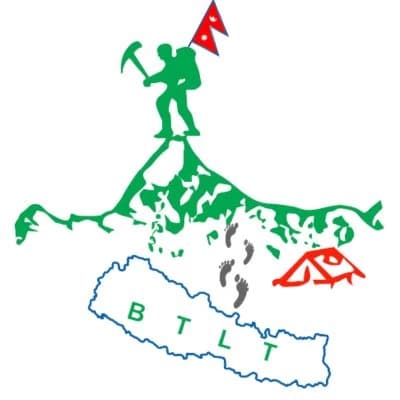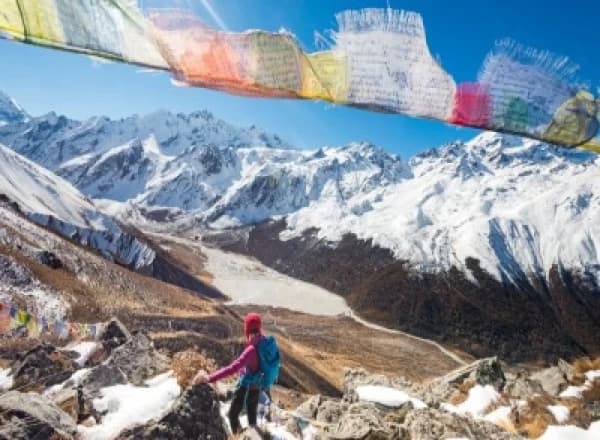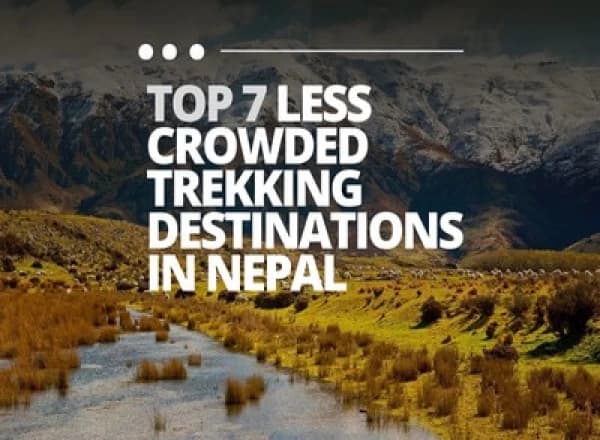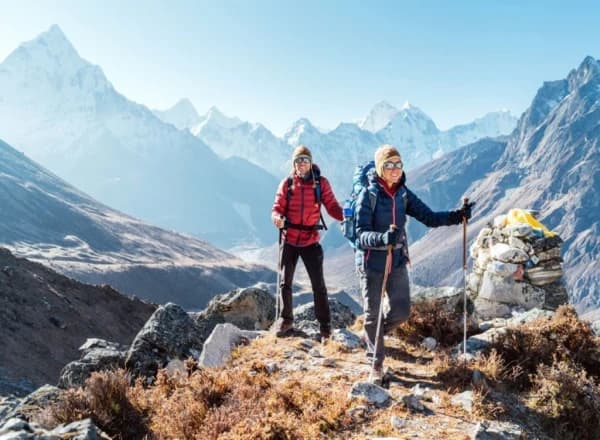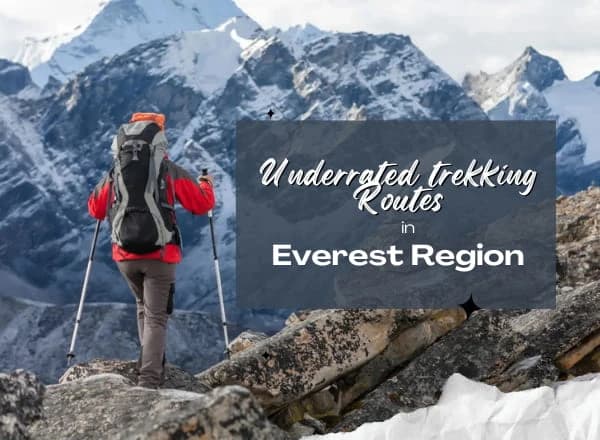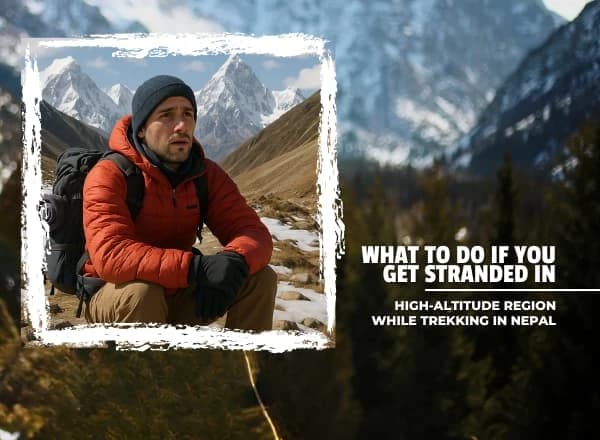Let us assist you in organizing your walk through Nepal's scenic trails so you may experience the wonder they hold.
1) Everest Base Camp:
The Everest Base Camp is the most popular trekking destination in Nepal, which brings you to the foot of Mount Everest, the highest point on Earth. It is a once-in-a-lifetime chance to experience the region's amazing splendor, where you'll come across charming Sherpa settlements, vibrant prayer flags, and breathtaking views of towering peaks.
- Altitude: At the Everest Base Camp, the trek reaches a height of 5,364 meters (17,598 feet).
- Transport: A picturesque flight from Kathmandu to Lukla is often the first leg of the trip to Everest Base Camp. Trekkers set out on foot from Lukla to explore the captivating scenery of the Everest region.
- Days of Trekking: Depending on the itinerary and acclimatization requirements, the Everest Base Camp trek takes 12 to 14 days.
Look also:
✔ 14 Days Everest Base Camp Trek
✔ Everest Base Camp Bed and Breakfast
✔ 8 Days Everest Panorama Trek
2) Manaslu Circuit Trek:
The Manaslu Circuit trip takes you around Mount Manaslu, the eighth-highest mountain in the world, and is an isolated and difficult expedition. A rare combination of natural beauty, rich cultural legacy, and a look into the way of life in the Tibetan-influenced towns may be found on an off-the-beaten-path walk.

- Altitude: The Larkya La Pass, which is at a noteworthy elevation of 5,106 meters, is the trek's highest point (16,752 feet).
- Transport: The trip from Kathmandu to Soti Khola is typically the first leg of the Manaslu Circuit trek. The journey begins there. Trekkers pass through a variety of environments on their route, including lush woods, alpine meadows, and harsh terrain.
- Days in Trek: You can choose the route and the pace which can make the Manaslu Circuit trek normally take 15 to 18 days to complete.
✔ Click here for details of this trek: Manaslu circuit trek.
3) Annapurna Circuit Trek:
The Annapurna Circuit Trek is without a doubt Nepal's most popular and celebrated, renowned for its various landscapes, breathtaking mountain views, and cultural immersion. This famous hike circles the entire Annapurna massif, providing an unparalleled adventure.

- Altitude: The trek's highest point is Thorong La Pass, which stands at 5,416 meters (17,769 feet).
- Transport: The trek to the Annapurna Circuit normally begins with a drive from Kathmandu to Besisahar. Trekkers continue by foot, going through green forests, terraced fields, and picturesque villages.
- Duration of the Trek: There is plenty of time to acclimatize and see the sights along the Annapurna Circuit, which can be completed in 18-21 days.
4) Annapurna Base Camp Trek:
The Annapurna Base Camp Trek, often known as the ABC trek, is an enthralling excursion across the Annapurna Sanctuary. By traveling through rhododendron forests, terraced farms, and traditional Gurung villages, this trip provides panoramic views of towering peaks like as Annapurna I, Machapuchare (Fishtail), and Hiunchuli.

- Altitude: The highest point of the Annapurna Base Camp walk is 4,130 meters above sea level (13,549 feet).
- Transportation: The climb to Annapurna Base Camp normally begins with a drive from Pokhara to Nayapul, the trek's starting point. Trekkers continue on through stunning landscapes and pleasant villages.
- Days in Trek: The Annapurna Base Camp trip typically takes 8 to 12 days to complete, depending on the itinerary and the pace of the trekker.
5) Mardi Himal Trek:
The Mardi Himal Trek is a hidden treasure in the Annapurna region, offering a less crowded and quieter alternative to the renowned hikes. This off-the-beaten-path trek takes you through pristine woods, charming villages, and breathtaking views, enabling you to absorb the serenity and grandeur of the Himalayas.

- Altitude: The highest point of the hike is Mardi Himal Base Camp, which is 4,500 meters above sea level (14,764 feet).
- Method of Transportation: The journey to Mardi Himal typically begins with a drive from Pokhara to Kande, the trek's starting point. Trekkers go on mind-boggling routes bordered by rhododendron trees and terraced farmland.
- Days in Trek: The Mardi Himal trip takes 6 to 8 days to complete, making it a shorter but equally rewarding option for trekkers looking for a lesser-known track.
✔ Check here for more treks in the Annapurna Region.
6) Langtang Valley Trek:
The Langtang Valley journey traverses Langtang National Park, which is renowned for its alpine meadows, magnificent glaciers, and the Tamang people's welcoming hospitality. This trek combines natural beauty with a cultural experience, with breathtaking views of Langtang Lirung and other neighbouring peaks.

- Altitude: Tserko Ri, at 4,984 meters in altitude, is the trek's highest point (16,350 feet).
- Transport: The journey to Langtang Valley normally begins with a drive from Kathmandu to Syabrubesi, the route's beginning location. Trekkers continue on through lush forests, charming villages, and scenic scenery.
- Duration of the Trek: Approximately 8 to 10 days are required to complete the Langtang Valley Trek, which offers a rewarding experience in a short amount of time.
✔ Explore more destinations in Langtang Region.
7) Khopra Danda Trek:
The Khopra Danda Trek is a hidden gem in the Annapurna region, offering a less crowded and off-the-beaten-path adventure. This trek takes you to the mesmerizing Khopra Ridge, also known as Khopra Danda, where you can witness breathtaking views of the Annapurna and Dhaulagiri mountain ranges.

- Altitude: The highest point of the trek is Khopra Danda, standing at an altitude of approximately 3,660 meters (12,008 feet).
- Mode of Transportation: The journey to Khopra Danda typically starts with a drive from Pokhara to Nayapul. From there, trekkers hike through charming villages, lush forests, and rhododendron-filled trails.
- Days in Trek: The Khopra Danda Trek usually takes around 6 to 9 days to complete, depending on the chosen itinerary and side trips.
The Khopra Danda Trek is a perfect choice for trekkers seeking a unique and less crowded experience in the Annapurna region. With stunning mountain views and the chance to encounter the warm hospitality of the local communities, this trek promises to be an unforgettable adventure amidst the magnificent mountains.
8) Everest Base Camp Trek With Return Helicopter Flight:
The Everest Base Camp Trek with a return helicopter flight option is a fantastic choice for those seeking an adventurous yet time-saving trekking experience. This trek follows the classic route to Everest Base Camp, taking you through picturesque Sherpa villages, ancient monasteries, and stunning landscapes. However, instead of retracing your steps on the way back, you have the option to take a thrilling helicopter flight, offering breathtaking aerial views of the Himalayas.

- Altitude: The trek reaches an altitude of 5,364 meters (17,598 feet) at Everest Base Camp.
- Mode of Transportation: The journey to Everest Base Camp starts with a scenic flight from Kathmandu to Lukla. From Lukla, trekkers trek on foot, immersing themselves in the mesmerizing landscapes of the Everest region. On the return journey, you have the option to take a helicopter flight from Gorak Shep, near Everest Base Camp, back to Lukla or Kathmandu.
- Days in Trek: The Everest Base Camp Trek with a return helicopter flight usually takes around 9 to 12 days to complete, depending on the itinerary and acclimatization needs.
Customization of the Treks:
While trekking in Nepal, there are several aspects of the trips that can be customized based on your preferences and requirements.
Here are some things that can be tailored to make your trekking experience more personalized:
- Itinerary: The trekking itineraries can be customized to fit your available time and physical fitness. You can choose to shorten or extend the duration of the trek, allowing for more rest days or additional exploration in certain areas.
- Accommodation: On the trek, there are a variety of lodgings available to suit a variety of budgets and comfort levels. From simple teahouses and guesthouses to opulent lodges and even camping in some regions, visitors are spoiled for choice.
- Guides and Porters: Hiring a knowledgeable guide or a team of porters can greatly enhance your trekking experience. Their knowledge of the area, assistance with navigation, and management of trip logistics will free you to focus on relaxing and appreciating your surroundings. You can choose to hire a guide, a porter, or both, depending on your needs.
- Food and Dietary Preferences: While trekking, most teahouses provide meals along the trail. You can customize your meals based on your dietary preferences or requirements. Whether you're a vegetarian, vegan, or have any specific food allergies, it's advisable to inform your guide or teahouse in advance to ensure they can cater to your needs.
- Side Trips and Extensions: Many trekking routes in Nepal offer opportunities for side trips or extensions to nearby attractions. You can customize your trek by adding detours to explore additional viewpoints, lakes, monasteries, or even neighboring villages. These side trips can add extra adventure and exploration to your overall trekking experience.
- Transportation: Depending on your convenience and budget, you can customize your mode of transportation to and from the trekking trailhead. For example, you can choose to fly in Helicopter from Kathmandu to Lukla and back for the Everest Base Camp trek or opt for a scenic road journey to the starting point of other treks.
- Group or Solo Trek: You can decide whether you prefer to join a group trek or embark on a solo adventure. Group treks offer the opportunity to meet fellow trekkers from around the world and share the experience, while solo treks provide a sense of freedom and flexibility in terms of pace and itinerary.
Remember, it's important to communicate your customization preferences to your trekking agency or guide in advance, so they can make the necessary arrangements and ensure a seamless trekking experience tailored to your needs.

In conclusion, Nepal's top trekking destinations offer a wealth of unique opportunities for exploration, learning, and development, as well as a stunning array of natural wonders. Each trek, from the well-known Everest Base Camp to the less-traveled Mardi Himal and Manaslu Circuit, offers its special blend of breathtaking scenery, quaint villages, and friendly locals.
No matter how much or how little travel experience you have, Nepal is a fantastic destination. The Himalayan landscapes, adorned with towering peaks, lush valleys, and diverse flora and fauna, create a mesmerizing backdrop for your trekking journey. The trails lead you through rhododendron forests, alpine meadows, and rugged terrains, rewarding you with breathtaking views at every turn.
Beyond the natural beauty, Nepal's treks provide an opportunity to immerse yourself in the rich cultural heritage of the country. Interact with the local communities, experience their warm hospitality, and witness age-old traditions that have been preserved for generations.
The customizable aspects of these treks allow you to tailor your experience to suit your preferences and requirements. Whether it's adjusting the itinerary, choosing accommodation options, or customizing meals, you have the freedom to create a trekking adventure that aligns perfectly with your desires.
So, what are you waiting for? Get your trekking gears ready cause Nepali mountains are calling!

Frequently Asked Questions:
1. Which Trek is The Most Popular in Nepal?
✔ There are many treks available in Nepal in different trekking Regions. However, Everest Base Camp and Annapurna Circuit Trek are Nepal's most popular treks. Everest, being the world's highest mountain, attracts adventurers seeking the ultimate altitude challenge, while Annapurna's diverse and stunning scenery offers unparalleled opportunities for adventure, making both treks equally rewarding for enthusiasts.
2. Which treks are lesser known in Nepal?
✔ Nepal is a Himalayan country so there are still many treks which hasn't been discovered yet. Among the discovered ones some of the lesser-known treks among tourists are:
3. What prior trekking experience do I need to trek in Nepal?
✔ There are treks available for different difficulty levels, ranging from easy to challenging. Picking a hike that is too difficult for your current level of fitness or experience is not a good idea. Hiring a knowledgeable guide can also ensure a safe and enjoyable trek, especially for beginners.
4. When is the best season or time to go trekking in Nepal?
✔ The months of March through May and September through November are perfect for trekking in Nepal. The stable climate, clear skies, and mild temperatures of these months make them ideal for hiking. However, with the right clothing and equipment, you can complete some treks even in the winter or monsoon.
5. How do I ensure I am fit for trekking in Nepal?
✔ The fitness level required for trekking in Nepal depends on the chosen trek. While some treks demand good physical fitness, there are easier treks suitable for beginners or those with moderate fitness levels. Regular exercise, like walking, hiking, or jogging, before your trek can help improve your stamina and prepare your body for the physical demands of trekking.
6. Are permits necessary for trekking in Nepal?
✔ Trekkers in Nepal need permits to enter most protected areas. The Trekker's Information and Management System (TIMS) card and the Annapurna Conservation Area Permit (ACAP) are two of the most common types of permits. Manaslu and Upper Mustang, both of which are in restricted areas, require additional permits. Permits for trekking in Nepal are typically acquired via official trekking agencies or the Nepal Tourism Board.
7. How do I avoid the risks of altitude sickness during trekking?
✔ Too rapid ascent to high altitudes can cause altitude sickness, also known as acute mountain sickness (AMS). Acclimatization is crucial, so make sure you take rest days, drink plenty of water, and slowly increase your altitude. It is smart to hire a guide who has experience monitoring health conditions and giving advice. Learn to recognize the warning signs of altitude sickness and let your guide know right away if you start to feel unwell.
8. What equipment and gear do I need to pack for trekking in Nepal?
✔ Essential trekking gear includes sturdy trekking boots, comfortable layered clothing, a backpack, a sleeping bag, trekking poles, a waterproof jacket, and a hat. It is recommended to bring a good quality map, a first aid kit, sunscreen, a water purification system, and basic toiletries. Pack wisely and keep your backpack as light as possible.
9. Can I trek solo in Nepal?
✔ While it is possible to trek independently in Nepal, it is highly recommended to hire a guide, especially for remote or less-traveled trails. A guide can assist with navigation, provide cultural insights, and ensure your safety throughout the trek. Additionally, having a guide enhances your overall experience by sharing local knowledge and stories.
Popular Trekking Packages:

